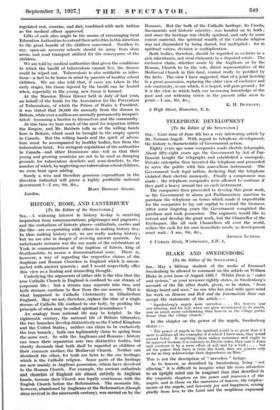HISTORY, ROME, AND CANTERBURY
[To the Editor of the SPECTATOR.] Sin,—A widening interest in history to-day is receiving inspiration from commemorations, pilgrimages and pageants ; and the custodians of historic places—cathedrals, castles and the like—are co-operating with others in making history live. In thus making history real, we are really making history; but we are also in danger of reviving ancient quarrels. An unfortunate instance was the use made of the celebrations at York in commemoration of the baptism of Edwin, king of Northumbria, to arouse a denominational issue. There is, however, a way of regarding the respective claims of the Anglican and Roman Churches in England which is uncon- nected with ancient quarrels ; and I would respectfully offer this view as a healing and reconciling thought.
Underlying the arguments of either side is the idea that the true Catholic Church in England is confined to one stream of corporate life : but a stream may separate into two, and both streams continue to flow from the one source. That is what happened to Catholic Christianity in Elizabethan England. May we not, therefore, replace the idea of a single stream of Catholic life confined to one body, by positing the principle of what may be called spiritual descendance ?
An analogy from national life may be helpful. In the eighteenth century, the national life of Britain bifurcates, the two branches develop distinctively as the United Kingdom and the United States.; neither can claim to be exclusively the true branch ; both can legitimately claim to spring from the same root. So with the Anglicans and Romans ; history can trace their separation into two distinctive bodies, but charity demands that both shall be regarded as children of their common mother, the Mediaeval Church. Neither can disinherit the other, for both are heirs to the one heritage, which is the Catholic religion. Some parts of the heritage are now mainly in Anglican possession, others have devolved to the Roman Church. For example, the ancient cathedrals
and churches of England are almost entirely in Anglican
hands, because their Church was legally continuous with the English Church before the Reformation. The monastic life, however, abandoned by Anglicans at the Reformation (though since revived in the nineteenth century), was carried on by the Romans. But the bulk of the Catholic heritage, its Creeds, Sacraments and historic ministry, was handed on to both ; and since the heritage was chiefly spiritual, and only to some extent material, the spiritual wealth of the Catholic religion was not diminished by being shared, but multiplied ; for in spiritual values, division is multiplication.
Both bodies, therefore, should be regarded as co-heirs in a rich inheritance, not rival claimants to a disputed estate. The exclusive claim, whether made by the Anglican, or by the Roman, Church to be the sole, direct representative of the Mediaeval Church in this land, cannot really be justified by the facts. The view I have suggested, that of a joint heirship in a great possession, replacing the older view of exclusive and sole continuity, is one which, it is hoped, will gain ground ; for it is the view to which both our increasing knowledge of the past and our widening vision in the present alike seem to point.—I am, Sir, &c., E. H. DUNKLEY. 2 High Street, Homerton, E. 9.










































 Previous page
Previous page